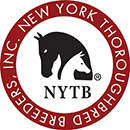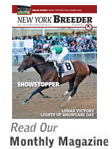Events related to the spread of COVID-19 have upended all of our lives at quantum speed. The juvenile sales season is disrupted, racing at NYRA is on hiatus and you are doing your best to navigate a breeding season unlike any you have experienced before. This month, I will use this space to pass along a few specific pieces of information I think you will find informative and useful at this time.
The economic health of the New York State Thoroughbred Breeding and Development Fund (the Fund) is obviously an issue for all of our stakeholders. Typically, the Fund derives on average $30,000 a day (or $900,000 a month) from VLT revenue. The other driver of Fund revenue of course is pari-mutuel handle. As you know, casinos are currently closed in the state and there is no racing due to COVID-19.
The other side of the coin is that 89% of Fund revenue is disbursed in awards. In other words, because no awards are being earned on the racetrack in New York currently, the interruption in revenue we hope will not create a shortfall for the Fund in the near term. There may be a time when racing resumes before the casinos come back on online, but the Fund is already taking precautionary measures to ensure cash flow so that it will be able to pay out awards.
Closer to home are issues affecting your employees. With Executive Order 206, beginning March 22, Governor Andrew Cuomo ordered 100% of the workforce for “non-essential” services across the state to stay home. This is not a guideline but a legal mandate. The NYS Department of Ag and Markets immediately issued guidance concerning essential animal care.
Specifically, Ag and Markets designated animal care operations, including equine, as “essential” and exempt from the Governor’s Executive Order. The farm owner / operator determines who falls within the category of “essential employees.” Visits to a farm or equine facility by anyone not designated as an essential employee are not permitted. Moreover, farm workers taking care of horses are still responsible for following CDC guidelines, including 6-foot social distancing, hand washing and sanitizing of facilities and equipment.
Finally, as the foaling and breeding season progresses, the Fund has already examined contingencies relevant to mare residency rules in the unlikely event that interstate travel restrictions are imposed in the future. Current rules state that resident mares who travel out of state to be bred must return to New York within 90 days of their last cover. Also, program participants may ship their non-resident mares back to their home state 90 days after they foal in New York.
The Fund has explored the residency concern and its conclusion after preliminary discussions is,
“Since the requirement for mares to be back in New York within 90 days of its last cover is regulatory (not statutory), the Fund has discretion in how it intends to enforce that rule under the circumstances. It seems . . . that if there are any substantial restrictions on the ability of owners or breeders to move their mares back into New York State as a result of the COVID-19 pandemic, the Fund would be well within its authority to review that condition in order for the mare to retain its status with the Fund.”
To conclude on a brighter note, we are seeing numerous examples of the best among us stepping up to help the thoroughbred community downstate. The New York Race Track Chaplaincy of America (NYRTCA), spearheaded by the organization’s president Ramon Dominguez, is raising funds to support backstretch workers and conducting a drive to restock its food pantry. The Belmont Child Care Association (BCCA) is accepting supplies for infants and toddlers. NYTHA President Joe Appelbaum and NYTHA Board Member Rick Schosberg are active at the track in concert with the Backstretch Employee Service Team (B.E.S.T) to support track workers. A Preparedness and Response Plan Committee, comprised of key NYRA staff members and the organizations just named has posted coronavirus-related signage in English and Spanish across the backstretch and is closely monitoring and assessing developments and developing key protocols to monitor and manage both the Aqueduct and Belmont properties. Details about all these activities apprear in articles on NYRA.com. I urge you to follow up there, where you will also find information about donating supplies or money to these worthy causes. Until next time, I wish you all good luck and good health.
Sincerely,
Jeffrey Cannizzo, Executive Director









